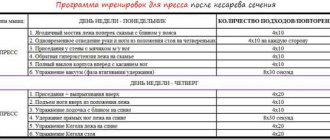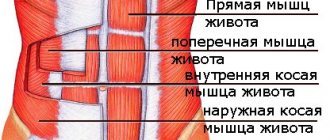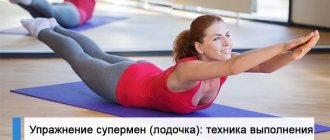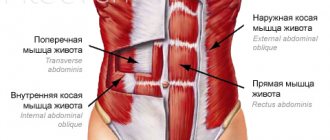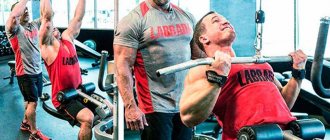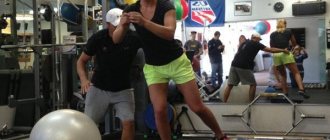What is diastasis?
A rectus abdominis stretch is an increase in the distance between two sections of the abdominal cavity (Rectus Abdominis). This discrepancy occurs in the area of the "white line" (Linea Alba), right in the middle of the collagenous connective tissue structures on the front of the abdomen.
During pregnancy, a woman's body undergoes many changes. And the body does not always return to its previous forms.
The rectus abdominis muscles extend from the ribs to the pubic bone. They help maintain an upright position and the stomach retracted.
During pregnancy, they stretch and form something like a depression or vacuum. The contents of the abdominal cavity seem to “bulge” outward.
Diastasis is usually asymptomatic; in some cases, the lower back may hurt if the abs are tense and not working properly. Even after giving birth, when a woman loses the weight she gained during pregnancy, she may still have a pregnancy-like belly. Usually in the evening the belly becomes more noticeable. Women who have given birth to twins have the greatest risk of developing diastasis.
It is important to note that this stretching remains after childbirth, and if diastasis is not treated in any way, everything will remain the same a year after childbirth. 66% of women with diastasis also have dysfunction of the pelvic floor muscles of varying degrees of severity.
The “linea alba” (the connective tissue that forms the meeting point of the abdominal muscles on both sides) loses strength and stability. All parts of the abdominals—the transverse, internal and external obliques, and the rectus abdominis—meet in this center line. Because of this, with diastasis, all the abdominal muscles are at risk and may not work as expected. This lack of protection and stability negatively affects the performance of the entire body, both aesthetically and functionally.
In this article, we have collected the most gentle exercises that will normalize the connective tissue of the abdomen without surgery and strengthen the abdominal muscles in general. Also here you will find exercises that it would be better to avoid so as not to aggravate the situation.
First you need to check if you have a sprain. The simple test below will help you make a diagnosis, or you can watch the video for clarity.
What does it look like?
When lifting the body from a lying position to a sitting position, the stomach takes the form of a “dome”, protruding. Sometimes it feels like several months of pregnancy. In addition to being aesthetically unattractive, diastasis is associated with weak core and pelvic muscles.
What causes diastasis?
The discrepancy is the result of excessive pressure or strain placed inside the abdominal cavity. Diastasis most often occurs in the last weeks of pregnancy, especially during the second and subsequent pregnancies. It is worth noting that pregnancy does not cause muscle strain. Pregnancy only aggravates the process of muscle separation in the abdomen due to uncontrolled load inside the peritoneum.
The rectus abdominis is just one of 4 layers of abdominal muscles: the transverse (deepest layer), the external and internal obliques (the next two layers), which form the outline of the waist, and then the rectus muscles on top.
When the two parts are stretched, the connective tissue between these muscles weakens and loses its elasticity. Other muscle and fascial structures also interact with it. This causes the front abdominal wall to lose support and stability. This line of connective tissue should be stretched along its entire length in a vertical plane (from the sternum to the pubis). But it cannot perform its functions optimally if the balance is disturbed.
Diastasis is a consequence of excessive and uncontrolled stress inside the abdominal cavity. Because of this load, other problems arise in the pelvic and abdominal area, such as hernia and prolapse. Therefore, the problem must be treated holistically, and this treatment should be aimed at aligning, reducing strain and strengthening the muscles of the entire core. The main attention should be paid not only to closing the diastasis.
How to determine
You can diagnose diastasis yourself, but after home diagnostics it is better to consult a doctor to completely confirm or refute the presence of the problem. The home method looks like this: lie on a hard, flat surface (preferably the floor) so that your back is completely adjacent to it, with your knees bent and your feet fully on the floor. The left hand is under the head, the right hand is in the navel area. Now we raise our head until the abs are tense, and at the same time we probe the stomach along the middle axis with our fingers, smoothly plunging our fingers into it. A large depression, clearly palpable with your fingers between the muscles, is diastasis. The stage is determined by the width of the depression:
- Stage I – discrepancy up to 5 cm;
- Stage II – discrepancy from 6 to 9 cm;
- Stage III – discrepancy of 15 cm or more.
The discrepancy is due to weak internal abdominal muscles - yes, we have those too. The location and appearance of the abdominal muscles depends on their condition. For this reason, diastasis is most common:
- In women during the postpartum period:
- after caesarean section;
- during the second and subsequent pregnancies.
- In weightlifters and powerlifters working with heavy weights.
In mothers, the fetus presses on the abdominal wall, stretching the connecting fibers; also, during a caesarean section, there is a high probability of cutting these fibers, which leads to loss of elasticity and loss of their main function - muscle fixation.
Athletes who work with heavy weights experience an excess weight load on the abdominal wall and internal abdominal muscles, which the rest of the muscles simply cannot handle - especially the back. Axiom: a weak, untrained back means an increased likelihood of developing diastasis.
The bad news: at stage III, abdominal exercises are practically useless; it is recommended to resort to abdominoplasty. This is a surgical intervention that restores the normal distance between the straight “cubes” of the press; we will not dwell on it here. Now the good news: correction of stages I and II and a tummy tuck without surgery are quite possible.
How do you know if you have diastasis?
Lie on your back, bend your knees, place your feet on the floor. Relax your head and shoulders and place your fingers (palm facing your face) directly above your navel.
Lift your head and neck very slowly up and press with your fingertips in the area above the navel. If you feel a dip inward, it means diastasis. Try not to lift your shoulders off the floor. Repeat the test several times in different places.
The stretch is measured by the width of the fingers. Most often, this discrepancy is 1-2 fingers wide, if more, then do not panic.
More important in this case is the tension and its lack in the area of the white line. When the muscles contract, there should be tension and resistance when you press your fingers into the area of the white line. If this is not the case, then the connective tissue needs to be restored.
Exercises for diastasis: complex 2
Straight leg raises
Lie on your back, place your arms at your sides and place your feet on the floor. Inhale, then exhale sharply and lift your hips toward your chest, keeping your back flat on the floor and your belly button pressed toward your spine. Maintain this position by extending and lifting one leg slightly off the ground. Then lift your heel toward the ceiling, keeping your legs and hips in a straight, vertical line. Then gently lower your heel back to the starting position (hovering above the ground). Do all these movements while keeping your abdominal muscles tense. Perform 12 reps with one leg, then 12 with the other.
Circles with legs
Lie on your back, place your arms at your sides and place your feet on the floor. Inhale, then exhale sharply and lift your hips toward your chest, keeping your back flat on the floor and your belly button pressed toward your spine. Lift one leg and extend it 45 degrees. Start making a small circle with your toe, imagining that you have a pencil between your fingers and are trying to draw a circle in the air. Do 12 circles outward, then another 12 circles inward (towards the other leg). Repeat the same sequence with the other leg.
Sitting sliders
*Note. You may need to wear socks to perform this exercise.
Sit against a wall with your lower back pressed against it, your shoulders relaxed, and your arms and legs on the ground. Bend your legs, then gently move them forward until they are fully extended. Focus on keeping your abs in constant tension. Slide your heels back to the starting position (knees slightly bent) and do 24 repetitions.
Side sliders
Stay in the same body position as in the exercise above. Then move both legs to the side, then return to the starting position. Do 24 reps.
Extended Leg Raises
Lie on your back with your feet flat on the floor, making sure your elbows are directly under your shoulders, your hips are tilted toward your chest, your lower back is glued to the ground, and your knees are bent. Lift one leg and extend it (the arch of the foot should be directed towards the ceiling, the kneecap should be pointing to the side). Maintain the bend in your knee as you carefully lift your leg to its highest point without losing your hip tilt, then lower back down—hovering slightly off the ground. Perform 12 one-leg raises, then switch legs.
Modified bar
*Note: This exercise can only be attempted if you have successfully completed all of the above. Don't attempt a plank if you feel like your core muscles are still weak or if you don't have full feeling of your transverse abdominis yet.
Start in a plank position on your forearms. While you hold this plank, focus on drawing your stomach in while breathing deeply and engaging the internal transverse abdominal muscles.
Do I need to wear a brace, bandage or elastic bandages?
The postpartum bandage has been used at all times. Abdominal support during pregnancy and immediately after it helps in some cases, you just need to wear it correctly. This will give stable support to the abdominals and lower back.
But even if you tighten the muscles tightly using a clamp, it does not guarantee that the white line will recover and remain in the same place. That is why you should not rely on a retainer or elastic bandages to return everything to its place, otherwise you will have to wear it constantly and for a very long time.
Remember that diastasis occurs due to excessive stress within the abdominal cavity and pelvis. This is pressure that the body cannot withstand, although it should. A brace and brace will not fix the problem; they will simply bring the two pieces back together after they have come apart, but will not restore the connective tissue between them. First you need to restore balance to the whole body and use the core muscles to remove diastasis.
All static abdominal exercises
These exercises involve holding the abdominal muscles without moving for some time. Such exercises can also be ordinary twisting, but only those performed WITHOUT MOVEMENT OF THE BODY UP AND DOWN. For example, keeping the shoulders up IN STATICS and the HUNDRED exercise:
Holding the press in static tension
Exercises HUNDRED
We perform these exercises from 40 seconds to 1-2 minutes in 3 approaches
What exercises and movements are best to avoid?
Twisting, squats, torso twists, planks, leg lifts from a lying position and holding them suspended are not recommended for diastasis.
Exercises to work the transverse press and to align and strengthen the core and pelvic floor muscles can be performed at any stage of diastasis development. If you do a lot of crunches or pump your abs, then most likely the sprain condition will worsen and the stomach will take on the characteristic “dome” shape. This is an example when the muscles were worked hard, but in the wrong direction. You won't be able to completely restore them to their previous position or pump them up, but you can restore strength, stability, and improve the appearance of your belly.
Plank
The “Plank” exercise and all its variants (classical and side planks) are static, which means that when performing them, you use the internal abdominal muscles, just like in a vacuum. Therefore, be sure to include planks in your anti-diastasis exercise routine if you want to see your flat tummy.
Abs workout with different plank variations
This complex is designed for a fairly advanced level. Of course, young mothers after the birth of a child are not in the best athletic shape, so you need to start doing the plank gradually with the simplest version of 3 sets of 40-60 seconds of holding statically, and then as your muscles begin to get stronger, you can add more and more complex modifications of this exercise and increase the time of the abdominal workout itself.
It is important to remember that when performing a plank with diastasis, you need to be even more careful about the technique of doing the exercise and SUCK YOUR ABDOMEN . Your abdominal muscles should not be relaxed even for a second! This is a very important point!
Notes
You can perform abdominal exercises for diastasis 3-4 weeks after giving birth.
What exercises will help close the discrepancy?
In order to prevent the appearance of diastasis, you need to start taking action directly during pregnancy.
Firstly, to reduce the risk of sprain to a minimum, try to maintain the weight you had before pregnancy, and do not gain more than the norm recommended by your doctor directly during pregnancy.
Most often, diastasis begins to gradually decrease 8 weeks after birth. If the condition has not changed or worsened after a year, you can resort to surgery. But this is not always mandatory.
Fitness can also help get rid of the discrepancy. Most abdominal exercises (before, during and after pregnancy) strengthen the entire core, combating potential strain. Most doctors agree that you should not start core training until you are at least 6-8 weeks postpartum.
First, you need to find the deep core muscles. Here's how to do it. Without lifting or straining your chest and shoulders, slowly, as you exhale, lower your belly in the navel area towards your back. These will be the deep muscles! There is no need to specifically pull in your stomach, hold your breath or make any sudden movements, that is, nothing should happen in the area of the shoulders, chest or pelvis.
If movements are present in these parts of the body, then the transverse muscles are not fully involved. Therefore, you need to find them first and reconnect with them, because they play an important role.
First you need to restore balance - the cause of this excessive pressure and strain. Then you need to learn to engage the transverse abdominal muscles and pelvic floor muscles not only when doing exercises, but in everyday life when lifting, sneezing and turning the body. These are natural movements that we do unconsciously. But in order to connect, align and restore muscles with diastasis, in the first stages you need to control all your movements.
Next, you will need to strengthen the transverse muscles so that the recti are reunited together, returning the abdomen to its previous flat shape.
Exercises for diastasis: complex 1
Routine daily duties
Changing your daily habits is the first thing you need to do. Leaning forward to pick something up off the floor is a big no-no (especially with a heavy toddler). This will allow your belly to sag, putting pressure on your already weak abdominal muscles. Instead, use your legs to perform squats when you lift anything (including your baby). As you rise to your feet, be mindful of keeping your core tight, pressing your belly button toward your spine, exercising your transverse abdominis, and using the strength of your arms and legs to help you handle the weight of the object you're lifting. See the photo below - the left side is wrong, the right side is correct.
Vacuum
Stand with your feet hip-distance apart and your stomach relaxed. Take a deep breath, then exhale through your mouth, draw in the front wall of your stomach and try to bring your navel closer to your spine. Hold this for 5-10 seconds. Inhale and repeat. Do this consistently throughout the day—seriously, the more the merrier!
Prohibited exercises
Prohibited for diastasis
With diastasis of the rectus abdominis muscles in women and men, exercises that cause an increase in intra-abdominal pressure are prohibited:
- any full crunches and abdominal swings;
- deflections and stretches of the body: bridge, reverse bridge, stretching of the abdominal muscles;
- raising legs to any point;
- weighted squats;
- lifting the legs and torso from a bend;
- push ups;
- yoga poses that stretch muscles;
- exercises on a fitball on the back;
- vacuum and bodyflex system.
You can determine whether an exercise is suitable for diastasis: start doing it, and if a muscle roll appears on the abdominal area, then such gymnastics is prohibited.
How else to fix the problem without surgery
Non-surgical methods of elimination are not only physical education and specific training, these include:
- taping,
- diet,
- massage,
- wearing a bandage.
They will give a positive result only if the degree of development of the divergence of the rectus abdominis muscles is within 1-2.
Taping
Taping is the application of special adhesive “plasters”, which is considered a physiological treatment and has a number of advantages:
- the cost of such therapy is as low as possible,
- the process is painless,
- the patient can continue to lead an active lifestyle and play sports,
- The treatment process continues around the clock.
The procedure for applying tapes is carried out in a supine position. A patch is applied along the width of the tear, the tension should be 30-50%, that is, there is no need to completely connect the separated abdominal muscles. The application of the patches must be repeated every 5-7 days. They are made of waterproof material and therefore, even after water procedures, remain in place of the original fixation.
The duration of such therapy for diastasis is 2 months.
Watch this video about how taping is performed for diastasis:
Diet to lose belly fat
Diet alone for diastasis will not have a positive effect; it must be combined with other therapeutic methods to solve the problem. But proper nutrition will speed up the process of restoring a flat stomach and help you lose weight if you have such a problem after childbirth.
What does the anti-abdominal diet for diastasis mean:
- The basis of nutrition is fibrous food. This includes vegetables, grains - apples, various cereals, herbs, zucchini, legumes, seaweed and a variety of vegetables.
- Fruits must be present in the daily menu. They should not be combined with porridge or cottage cheese; it is better to present them as a separate “dish”. The best choice for solving the problem of diastasis would be apples, pears, oranges and grapefruits. They should be consumed during second breakfast (allowed to be combined with natural yogurt) or as an afternoon snack.
- Proteins are a component of muscle fibers. Since it is necessary to strengthen the rectus abdominis muscles and increase their contractility, protein foods must be present on the menu. Once a week you need to eat 200-300 g of fish, twice a week - white poultry meat in the amount of 300-400 g. The diet should also contain eggs, nuts and seeds, but not more than 50 g per day.
Animal fats are completely excluded from the diet; preference should be given to vegetable oils - olive, flaxseed, pumpkin, corn and sunflower. All salads and dishes are seasoned with sauces based on the listed oils.
Meals for diastasis should be fractional - meals are taken 5-6 times a day and in small portions (maximum 250 g per meal). It is also important to observe the drinking regime - drink at least one and a half liters of clean water per day. The indicated volume does not include soups, compotes, teas, coffee and other drinks.
Massage
Massage does not have a pronounced effect on the abdominal muscle tissue, but doctors recommend it for diastasis as the first remedy. After a natural birth, the procedure can be performed after 3-4 weeks, after a cesarean section - no earlier than 2 months, but these indicators are individual and must be confirmed by a gynecologist and surgeon.
| Massage techniques | Effect |
| Stroking |
|
| Rubbing |
|
| Kneading |
|
| Striking techniques |
|
| Vibration techniques (final) |
|
You can perform the massage yourself or seek help from specialists. It is important to perform the procedure regularly - for example, every other day. The duration of the course is at least 3 months; during this period both specific nutrition and physical activity must be present.
Will a bandage help?
The bandage should be worn after childbirth, cesarean section and used as support and fixation of the abdominal muscles during exercise. The bandage itself will not help solve the problem, but it will be an auxiliary element of the complex effect on the rectus abdominis muscles.
Causes of diastasis after childbirth and provoking factors
The abdominal wall consists of supporting and connecting tissue, including collagen fibers. Due to pregnancy hormones, the tension in the fibers decreases and they begin to stretch, and the abdominal muscles give way to the growing baby. The separation of the rectus abdominis muscles along the midline of the connective tissue connecting them (linea alba) is called diastasis. The linea alba runs from the bottom of the sternum to the top of the pubis and is usually about 1 cm wide. Diastasis can occur anywhere from the top to the bottom of the midline. After delivery, this process will resolve itself and the collagen fibers will regain their normal traction force. However, prolonged stretching or tearing of the fibers may cause the binding tissue to fail to fully repair itself.
Having diastasis is completely normal during the third trimester. However, there are a number of factors that can increase the likelihood of developing a disorder that will be difficult to correct:
- Pregnancy after 35 years
- Already have two or more children
- C-section
- Pregnancy with twins or triplets
- Large baby or increased amount of amniotic fluid
- Incorrect type of load on linea alba during pregnancy
- Constant constipation
- The wrong kind of strength training during or after pregnancy
Breathing exercises for diastasis
Set of exercises "Bodyflex"
It is very useful to do breathing exercises when you are ill, but bodyflex for diastasis of the rectus abdominis muscles is prohibited unless the doctor recommends otherwise. Diaphragmatic breathing is one of the best types of gymnastics:
- As you inhale, expand the chest, relaxing the stomach.
- They try to straighten the lower ribs.
- As you exhale, return to your normal position.
- Make sure that breathing occurs through the stomach and lower part of the chest.
This gymnastics can be performed anywhere. But it is best to practice in a calm environment with good access to oxygen.
There are many breathing practices for improving abdominal muscles, including yoga. But you cannot create a vacuum when performing these exercises.
Types of diastasis
There are 3 degrees of pathological changes in the white line of the abdomen:
- the first degree is diagnosed when there is a discrepancy of the rectus muscles of no more than 5 cm. In this case, the usual shape of the abdomen is preserved, there are no medical complaints;
- in the second degree, the widened strip of the midline reaches 6-10 cm. Aesthetic problems are aggravated: the stomach protrudes in the lower part, the waist is smoothed and the figure “expands”. Unpleasant symptoms appear, such as pain when walking or exercising;
- the third degree is characterized by stretching of the connective tissue along the entire vertical line to a distance of more than 10 cm. Along with the formation of an unsightly sagging abdomen, poor posture and prolapse of internal organs develop.
How to avoid diastasis in children, men and women
You can avoid diastasis if you follow the following recommendations from experts:
- sports should be present in the lives of men, women and children constantly,
- physical activity should be moderate, it can be increased gradually and only under the supervision of an instructor,
- It is advisable not to lift weights “on your hands”, but if necessary, taking a load “on your stomach” is strictly prohibited.
If we are talking about the risk of developing diastasis after childbirth, then a woman should remember:
- the need to wear a bandage after childbirth,
- prohibition of lifting weights, even average weights must be lifted correctly - bending the elbows and pressing them to the body,
- the healthiest sleeping position is on your back or side, but not on your stomach,
- control the condition of the abdominal muscles - they need to be constantly tensed, retracted,
- correct posture.
